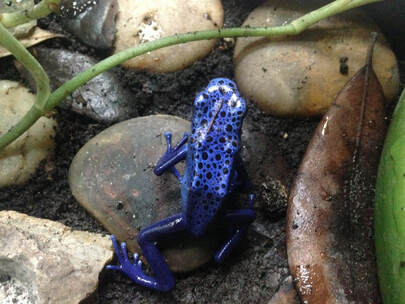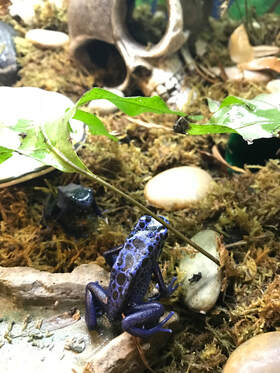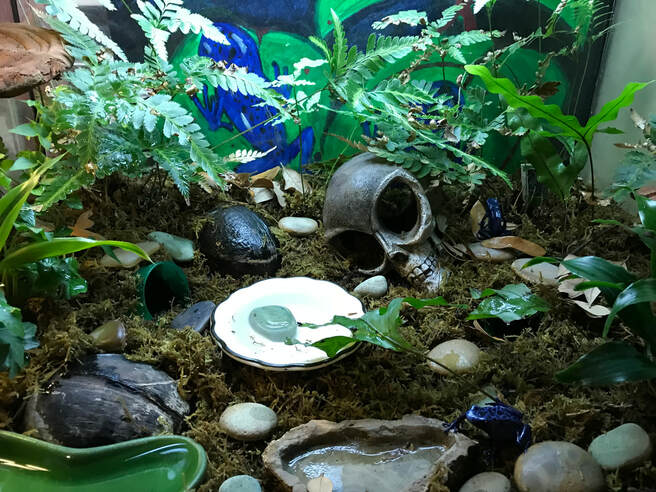 Dr. Horton's male D. azureus.
Dr. Horton's male D. azureus.
Keeping Dart Frogs
By Susan Horton, DVM
Dart frogs are one of the most colorful and interesting frog species kept in captivity. These small frogs come in a rainbow of colors and patterns. Dart frogs are any species of frog belonging to the family of Dendrobatidae. Dendrobates, Phyllobates, Epipedobates are all part of this family plus a few others. Their husbandry may seem complex, but if you follow our care guidelines you will have success!
You may know them as poison dart frogs, but all captive raised dart frogs have lost their toxicity. Their name comes from the toxins they secret in the wild for protection. South American Indian tribes used this toxin on their arrows for hunting. They depend on specific insect meals in the wild to charge up their toxins. We do recommend that you choose captive raised frogs as they will be most likely the thrive in your vivarium.
Pairing Dart Frogs
There are two general groups that dart frogs can be put into for caging in general. There are those that do well in individually sexed pairs and those that can handle groups. The ones that can be kept in same species groups are Epipedobates, Phyllobates, Dendrobates auratus and D. leucomelas. Periodically, some territorial aggression may occur. Never crowd your frogs and this shouldn’t be a problem.
D. tinctorius and D. azureus, and the rest of the species should only be kept in individual pairs as adults. The challenge is in getting male and female frogs as they are sold before they are sold when they are very young. Picking out three young individuals may increase your odds of getting a pair. Separate out the extra mismatched individual when they are old enough to tell sex. Periodically you can find older animals and go that route instead.
Sexing individuals is difficult until they reach adulthood usually at around 1 year old. Females are usually larger (longer and wider) than males. Males have distinctive calls used during breeding. D. tinctorius males may have larger toes pads. Sexing will be difficult and fairly subjective even to advanced keepers.
Diet
These frogs start out on wingless fruit flies. Springtails, isopods, rice flour beetles and pinhead crickets are also an option. All insects must be dusted with a premium vitamin supplement that includes calcium, D3, and vitamin A. Feeding occurs daily especially for the young frogs. Mature frogs may be fed every other day unless actively producing eggs. If this is the case, continue the daily feeding. Generally, and adult frog will take about a half teaspoon of insects daily. Reduce this feeding if these insects aren’t completely consumed in one day. Choose a feeding area and use a flat, shallow dish to pour the insects onto. This allows for easy cleaning and your frogs will habituate to this area at feeding time. Dart frogs are day feeders, so you should be able to get a good look at them during feeding.
Water/Humidity
Do make sure there are adequate water features available. This can be a simple bowl or two or s recirculating system. The key is to always have clean, chlorine, and chloramine free water available. Humidity is provided by the vivarium but must be supplemented with either daily misting or a fogger system. This must not make the vivarium soggy. Adequate drainage is a must have! Humidity should be high at 75% or above. Be sure you have a thermometer and hygrometer to monitor temperature and humidity.
Housing
These frogs do best in a vivarium that has adequate drainage, is well planted, and has many hides available for security. Choose a glass enclosure with good ventilation on top via screening and large front doors for ease of access. The smallest size that you might go with should be at least 24” x 12” x 16”, but larger is better. Be sure there are no gaps that the frogs can escape through. Select an appropriate background that enhances your plantings and gives the frogs security. The substrate in the vivarium is a complex layering of ingredients that help the frogs and plants thrive. This allows for the soil to be adequately aerated for the plants, but also pull the excess moisture away from the frogs.
The bottom layer of the vivarium should have a substrate that will not break down in water. Gravel or clay potting balls (LECA, Hydro-balls, Feather-lite, Terra-lite) work well here. This layer should be at least 1 - 2 inches deep. Covering this layer, is yard fabric. This keeps the base layer from getting bogged down with the soil. On top of the yard fabric, a layer of activated charcoal helps detoxify accumulating waste. Above this level is your healthy soil. Organic mixes that have no chemical fertilizers or insecticides added are best. This level should be at least 4-5 inches deep. This is your planting soil. Create an interesting terrain with different heights in the terrarium. Plant larger plants in back and shorter plants in front for a layered look. Install your hides and water feature. Create a focal point with interesting driftwood. Have levels in the terrarium with side glass mounted lichens, etc. Be sure everything is easily accessible for cleaning. Lastly, add the damp moss, leaves, flat smooth rocks around your plantings for the final effect. Be sure all cage furniture is secure and cannot harm the frogs. The vivarium should be interesting for both you and the frogs.
We do recommend periodic soil disturbance via gentle tiling every 2-3 months. The moss will need replacement at this time. Soil should be fully renewed every 6 months. This allows you to remove any toxins that have accumulated and redecorate. Do not disturb the garden fabric or the clay balls as they are areas where beneficial bacteria live. Never allow water to accumulate above the clay balls. The plants are watered as needed. The addition of springtails may help reduce waste material.
Lighting and Temperature
Low level UVB is important for the frogs to thrive. The lighting should also be adequate for the plants to do well, too. The lighting should be place directly above the terrarium on a screen. There can be no glass or plastic between the light and the frogs otherwise the UVB will be blocked. Brighter is better as you will enjoy seeing your plants and frogs. Dart frogs prefer to be kept between 70-78 degrees. This is commonly room temperature. If you room is routinely going to be cooler than this. A low-level heat source may be necessary.
Handling
It is important to note that these frogs should not be picked up and handled. When you need to move them, use a clean tub with a lid and gentle coax them into it. You can easily crush these delicate frogs with your fingers. If there is a valid reason that you need to touch them, wear nitrile gloves. This will protect the frog from anything you may have on your skin.
Common Disorders
Spindly leg
Short tongue
Chytrid fungus
Parasites
Enteritis/Intestinal infection
Skin infection
Vital Statistics
Life spans of 7-10 years
Size ranges from 3/4" – 2.5".
From the tropical areas of Central and South America
Habitats include the leaf litter on the forest floor to high up in the canopy
Temperature 70F – 78F
Humidity 75% and 100%
Following the acquisition of your dart frogs, they should be taken to a reptile veterinarian for a general health check and a fecal exam for parasites.
Additional Reading
The Complete Oophaga pumilio (Central American Poison Dart Frog, Dendrobatidae) - Biology, Ecology, Captive Husbandry. Steinman, F, van der Lingren, C.
Poison Frogs (Professional Breeders Series). Schmidt, W, Henkel, FW.
By Susan Horton, DVM
Dart frogs are one of the most colorful and interesting frog species kept in captivity. These small frogs come in a rainbow of colors and patterns. Dart frogs are any species of frog belonging to the family of Dendrobatidae. Dendrobates, Phyllobates, Epipedobates are all part of this family plus a few others. Their husbandry may seem complex, but if you follow our care guidelines you will have success!
You may know them as poison dart frogs, but all captive raised dart frogs have lost their toxicity. Their name comes from the toxins they secret in the wild for protection. South American Indian tribes used this toxin on their arrows for hunting. They depend on specific insect meals in the wild to charge up their toxins. We do recommend that you choose captive raised frogs as they will be most likely the thrive in your vivarium.
Pairing Dart Frogs
There are two general groups that dart frogs can be put into for caging in general. There are those that do well in individually sexed pairs and those that can handle groups. The ones that can be kept in same species groups are Epipedobates, Phyllobates, Dendrobates auratus and D. leucomelas. Periodically, some territorial aggression may occur. Never crowd your frogs and this shouldn’t be a problem.
D. tinctorius and D. azureus, and the rest of the species should only be kept in individual pairs as adults. The challenge is in getting male and female frogs as they are sold before they are sold when they are very young. Picking out three young individuals may increase your odds of getting a pair. Separate out the extra mismatched individual when they are old enough to tell sex. Periodically you can find older animals and go that route instead.
Sexing individuals is difficult until they reach adulthood usually at around 1 year old. Females are usually larger (longer and wider) than males. Males have distinctive calls used during breeding. D. tinctorius males may have larger toes pads. Sexing will be difficult and fairly subjective even to advanced keepers.
Diet
These frogs start out on wingless fruit flies. Springtails, isopods, rice flour beetles and pinhead crickets are also an option. All insects must be dusted with a premium vitamin supplement that includes calcium, D3, and vitamin A. Feeding occurs daily especially for the young frogs. Mature frogs may be fed every other day unless actively producing eggs. If this is the case, continue the daily feeding. Generally, and adult frog will take about a half teaspoon of insects daily. Reduce this feeding if these insects aren’t completely consumed in one day. Choose a feeding area and use a flat, shallow dish to pour the insects onto. This allows for easy cleaning and your frogs will habituate to this area at feeding time. Dart frogs are day feeders, so you should be able to get a good look at them during feeding.
Water/Humidity
Do make sure there are adequate water features available. This can be a simple bowl or two or s recirculating system. The key is to always have clean, chlorine, and chloramine free water available. Humidity is provided by the vivarium but must be supplemented with either daily misting or a fogger system. This must not make the vivarium soggy. Adequate drainage is a must have! Humidity should be high at 75% or above. Be sure you have a thermometer and hygrometer to monitor temperature and humidity.
Housing
These frogs do best in a vivarium that has adequate drainage, is well planted, and has many hides available for security. Choose a glass enclosure with good ventilation on top via screening and large front doors for ease of access. The smallest size that you might go with should be at least 24” x 12” x 16”, but larger is better. Be sure there are no gaps that the frogs can escape through. Select an appropriate background that enhances your plantings and gives the frogs security. The substrate in the vivarium is a complex layering of ingredients that help the frogs and plants thrive. This allows for the soil to be adequately aerated for the plants, but also pull the excess moisture away from the frogs.
The bottom layer of the vivarium should have a substrate that will not break down in water. Gravel or clay potting balls (LECA, Hydro-balls, Feather-lite, Terra-lite) work well here. This layer should be at least 1 - 2 inches deep. Covering this layer, is yard fabric. This keeps the base layer from getting bogged down with the soil. On top of the yard fabric, a layer of activated charcoal helps detoxify accumulating waste. Above this level is your healthy soil. Organic mixes that have no chemical fertilizers or insecticides added are best. This level should be at least 4-5 inches deep. This is your planting soil. Create an interesting terrain with different heights in the terrarium. Plant larger plants in back and shorter plants in front for a layered look. Install your hides and water feature. Create a focal point with interesting driftwood. Have levels in the terrarium with side glass mounted lichens, etc. Be sure everything is easily accessible for cleaning. Lastly, add the damp moss, leaves, flat smooth rocks around your plantings for the final effect. Be sure all cage furniture is secure and cannot harm the frogs. The vivarium should be interesting for both you and the frogs.
We do recommend periodic soil disturbance via gentle tiling every 2-3 months. The moss will need replacement at this time. Soil should be fully renewed every 6 months. This allows you to remove any toxins that have accumulated and redecorate. Do not disturb the garden fabric or the clay balls as they are areas where beneficial bacteria live. Never allow water to accumulate above the clay balls. The plants are watered as needed. The addition of springtails may help reduce waste material.
Lighting and Temperature
Low level UVB is important for the frogs to thrive. The lighting should also be adequate for the plants to do well, too. The lighting should be place directly above the terrarium on a screen. There can be no glass or plastic between the light and the frogs otherwise the UVB will be blocked. Brighter is better as you will enjoy seeing your plants and frogs. Dart frogs prefer to be kept between 70-78 degrees. This is commonly room temperature. If you room is routinely going to be cooler than this. A low-level heat source may be necessary.
Handling
It is important to note that these frogs should not be picked up and handled. When you need to move them, use a clean tub with a lid and gentle coax them into it. You can easily crush these delicate frogs with your fingers. If there is a valid reason that you need to touch them, wear nitrile gloves. This will protect the frog from anything you may have on your skin.
Common Disorders
Spindly leg
Short tongue
Chytrid fungus
Parasites
Enteritis/Intestinal infection
Skin infection
Vital Statistics
Life spans of 7-10 years
Size ranges from 3/4" – 2.5".
From the tropical areas of Central and South America
Habitats include the leaf litter on the forest floor to high up in the canopy
Temperature 70F – 78F
Humidity 75% and 100%
Following the acquisition of your dart frogs, they should be taken to a reptile veterinarian for a general health check and a fecal exam for parasites.
Additional Reading
The Complete Oophaga pumilio (Central American Poison Dart Frog, Dendrobatidae) - Biology, Ecology, Captive Husbandry. Steinman, F, van der Lingren, C.
Poison Frogs (Professional Breeders Series). Schmidt, W, Henkel, FW.


